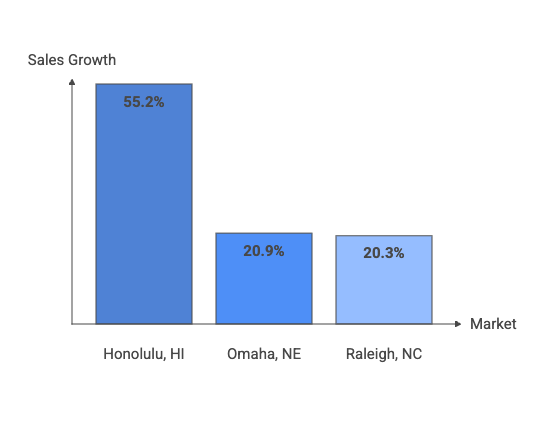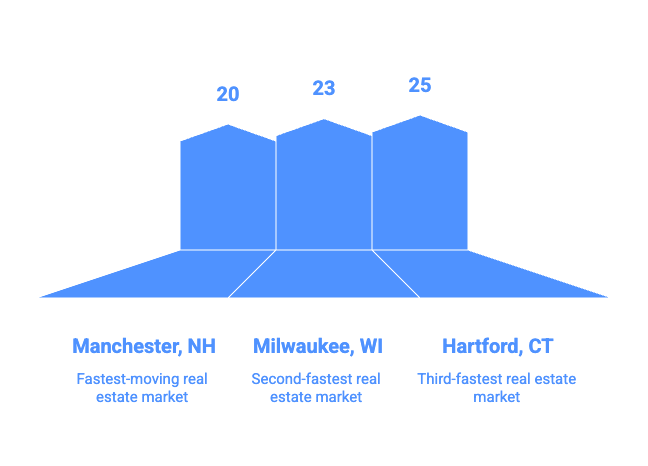
In the 52 metro areas surveyed in September 2025, the number of newly listed homes was up 0.9% compared to September 2024, and up 4.5% compared to August 2025. The markets with the biggest year-over-year increase in new listings percentage were Omaha, NE at +20.9%, Fayetteville, AR at +20.1%, and Wichita, KS at +18.7%. The markets with the biggest decrease in year-over-year new listings percentage were Trenton, NJ at -38.3%, Dover, DE at -32.5%, and Baltimore, MD at -28.7%.

Of the 52 metro areas surveyed in September 2025, the overall number of home sales was up 8.5% compared to September 2024, and down 4.6% compared to August 2025. The markets with the biggest increase in year-over-year sales percentage were Honolulu, HI at +55.2%, Omaha, NE at +20.9%, and Raleigh, NC at +20.3%. The markets with the biggest decrease in year-over-year sales percentages were Dover, DE at -10.6%, Fayetteville, AR at -0.8%, and Indianapolis, IN at -0.3%.

In September 2025, the median of all 52 metro area sales prices was $439,000, up 2.1% from September 2024, and down 1.3% compared to August 2025. The markets with the biggest year-over-year increase in median sales price were Milwaukee, WI at +11.5%, Trenton, NJ at +10.6%, and Coeur d’Alene, ID at +9.2%. The markets with the biggest year-over-year decrease in median sales price were Houston, TX at -2.7%, Tampa, FL at -2.4%, and Honolulu, HI at -1.8%.

In September 2025, the average close-to-list price ratio of all 52 metro areas in the report was 98%, down from 99% in both September 2024 and August 2025. The close-to-list price ratio is calculated by the average value of the sales price divided by the list price for each transaction. When the number is above 100%, the home closed for more than the list price. If it’s less than 100%, the home sold for less than the list price. The metro areas with the lowest close-to-list price ratios were Miami, FL at 94.1%, Bozeman, MT at 95.4%, and New Orleans, LA at 95.8%. The metro areas with the highest close-to-list price ratio were Hartford, CT at 102.9%, San Francisco, CA at 101.8%, and Manchester, NH at 101.0%.

The average days on market for homes sold in September 2025 was 48, up seven days compared to the average in September 2024 and up one day compared to August 2025. The metro areas with the highest days on market averages were San Antonio, TX at 88, Miami, FL at 83 and Coeur d’Alene, ID at 77. The lowest days on market were Manchester, NH at 20, Milwaukee, WI at 23 and Hartford, CT at 25. Days on market is the number of days between when a home is first listed in an MLS and a sales contract is signed.

Inventory was 20% higher year-over-year – as September became the 21st consecutive month of annual growth. Home sales in September were 8.5% higher than a year ago, marking the fourth month in 2025 where sales outpaced the previous year. Compared to August, sales declined 4.6% while inventory rose 3.1% – typical shifts for this time of year.
According to data from the 52 metro areas surveyed, buyers paid less for the third straight month as sellers accepted 98% of the asking price in September, down from 99% in both August 2025 and September 2024. The Median Sales Price in September was $439,000, a decrease of $6,000 (1.3%) from August but an increase of $9,000 (2.1%) compared to September 2024. This marked 27 consecutive months of year-over-year price gains. July’s median sales price of $450,000 was the highest recorded year to date.
Other metrics of note:
“Smart buyers are turning to their agents for strategic guidance – and it’s paying off, as many are still successfully negotiating favorable prices,” said REMAX CEO Erik Carlson. “At the same time, sellers can be confident in the continued demand for homes. As inventory grows and market dynamics shift, the months ahead may bring more balance to the market.”
While many markets experienced slightly lower median sales prices and longer days on market, Milwaukee, Wisconsin stood out in contrast, posting the largest year-over-year increase in median sales price (+11.5%) and ranked among the fastest-selling markets with an average of just 23 days on market.
The RE/MAX National Housing Report is distributed each month on or about the 15th. The first Report was distributed in August 2008. The Report is based on MLS data in approximately 53 metropolitan areas, includes all residential property types, and is not annualized. For maximum representation, many of the largest metro areas in the country are represented, and an attempt is made to include at least one metro from each state. Metro area definitions include the specific counties established by the U.S. Government’s Office of Management and Budget, with some exceptions.
Transactions are the total number of closed residential transactions during the given month. Months Supply of Inventory is the total number of residential properties listed for sale at the end of the month (current inventory) divided by the number of sales contracts signed (pended) during the month. Where “pended” data is unavailable, this calculation is made using closed transactions. Days on Market is the number of days that pass from the time a property is listed until the property goes under contract for all residential properties sold during the month. Median Sales Price is the median of the median sales prices in each of the metro areas included in the survey.
MLS data is provided by contracted data aggregators, RE/MAX brokerages and regional offices. While MLS data is believed to be accurate, it cannot be guaranteed. MLS data is constantly being updated, making any analysis a snapshot at a particular time. Every month the RE/MAX National Housing Report re-calculates the previous period’s data to ensure accuracy over time. All raw data remains the intellectual property of each local MLS organization.